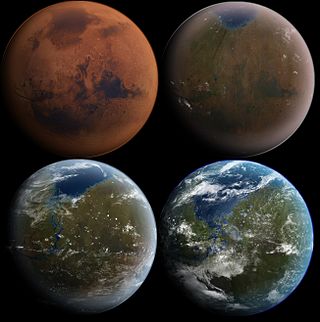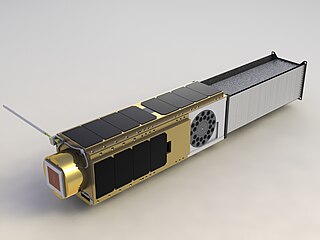
Astrobiology is a scientific field within the life and environmental sciences that studies the origins, early evolution, distribution, and future of life in the universe by investigating its deterministic conditions and contingent events. As a discipline, astrobiology is founded on the premise that life may exist beyond Earth.

An extremophile is an organism that is able to live in extreme environments, i.e., environments with conditions approaching or expanding the limits of what known life can adapt to, such as extreme temperature, radiation, salinity, or pH level.

Panspermia is the hypothesis that life exists throughout the Universe, distributed by space dust, meteoroids, asteroids, comets, and planetoids, as well as by spacecraft carrying unintended contamination by microorganisms, known as. The theory argues that life did not originate on Earth, but instead evolved somewhere else and seeded life as we know it.

Terraforming or terraformation ("Earth-shaping") is the hypothetical process of deliberately modifying the atmosphere, temperature, surface topography or ecology of a planet, moon, or other body to be similar to the environment of Earth to make it habitable for humans to live on.

An endolith or endolithic is an organism that is able to acquire the necessary resources for growth in the inner part of a rock, mineral, coral, animal shells, or in the pores between mineral grains of a rock. Many are extremophiles, living in places long considered inhospitable to life. The distribution, biomass, and diversity of endolith microorganisms are determined by the physical and chemical properties of the rock substrate, including the mineral composition, permeability, the presence of organic compounds, the structure and distribution of pores, water retention capacity, and the pH. Normally, the endoliths colonize the areas within lithic substrates to withstand intense solar radiation, temperature fluctuations, wind, and desiccation. They are of particular interest to astrobiologists, who theorize that endolithic environments on Mars and other planets constitute potential refugia for extraterrestrial microbial communities.

Geomicrobiology is the scientific field at the intersection of geology and microbiology and is a major subfield of geobiology. It concerns the role of microbes on geological and geochemical processes and effects of minerals and metals to microbial growth, activity and survival. Such interactions occur in the geosphere, the atmosphere and the hydrosphere. Geomicrobiology studies microorganisms that are driving the Earth's biogeochemical cycles, mediating mineral precipitation and dissolution, and sorbing and concentrating metals. The applications include for example bioremediation, mining, climate change mitigation and public drinking water supplies.

The possibility of life on Mars is a subject of interest in astrobiology due to the planet's proximity and similarities to Earth. To date, no proof of past or present life has been found on Mars. Cumulative evidence suggests that during the ancient Noachian time period, the surface environment of Mars had liquid water and may have been habitable for microorganisms, but habitable conditions do not necessarily indicate life.

Planetary protection is a guiding principle in the design of an interplanetary mission, aiming to prevent biological contamination of both the target celestial body and the Earth in the case of sample-return missions. Planetary protection reflects both the unknown nature of the space environment and the desire of the scientific community to preserve the pristine nature of celestial bodies until they can be studied in detail.

EXPOSE is a multi-user facility mounted outside the International Space Station (ISS) dedicated to astrobiology. EXPOSE was developed by the European Space Agency (ESA) for long-term spaceflights and was designed to allow exposure of chemical and biological samples to outer space while recording data during exposure.

The O/OREOS is a NASA automated CubeSat nanosatellite laboratory approximately the size of a loaf of bread that contains two separate astrobiology experiments on board. Developed by the Small Spacecraft Division at NASA Ames Research Center, the spacecraft was successfully launched as a secondary payload on STP-S26 led by the Space Test Program of the United States Air Force on a Minotaur IV launch vehicle from Kodiak Island, Alaska on 20 November 2010, at 01:25:00 UTC.
Interplanetary contamination refers to biological contamination of a planetary body by a space probe or spacecraft, either deliberate or unintentional.
Richard Brice Hoover is a physicist who has authored 33 volumes and 250 papers on astrobiology, extremophiles, diatoms, solar physics, X-ray/EUV optics and meteorites. He holds 11 U.S. patents and was 1992 NASA Inventor of the Year. He was employed at the United States' NASA Marshall Space Flight Center from 1966 to 2012, where he worked on astrophysics and astrobiology. He established the Astrobiology Group there in 1997 and until his retirement in late 2011 he headed their astrobiology research. He conducted research on microbial extremophiles in the Antarctic, microfossils, and chemical biomarkers in precambrian rocks and in carbonaceous chondrite meteorites. Hoover has published claims to have discovered fossilized microorganisms in a collection of select meteorites on multiple occasions.

Chroococcidiopsis is a photosynthetic, coccoidal bacterium, and the only genus in the order Chroococcidiopsidales and in the family Chroococcidiopsidaceae. A diversity of species and cultures exist within the genus, with a diversity of phenotypes. Some extremophile members of Chroococcidiopsis are known for their ability to survive harsh environmental conditions, including both high and low temperatures, ionizing radiation, and high salinity.

Icebreaker Life is a Mars lander mission concept proposed to NASA's Discovery Program. The mission involves a stationary lander that would be a near copy of the successful 2008 Phoenix and InSight spacecraft, but would carry an astrobiology scientific payload, including a drill to sample ice-cemented ground in the northern plains to conduct a search for biosignatures of current or past life on Mars.
ExoLance is a low-cost mission concept that could hitch a ride on other missions to Mars in an effort to look for evidence of subsurface life.

The Tanpopo mission is an orbital astrobiology experiment investigating the potential interplanetary transfer of life, organic compounds, and possible terrestrial particles in the low Earth orbit. The purpose is to assess the panspermia hypothesis and the possibility of natural interplanetary transport of microbial life as well as prebiotic organic compounds.
Exposing Microorganisms in the Stratosphere (E-MIST) is a NASA study to determine if a specific microorganism could survive conditions like those on the planet Mars. The study transported Bacillus pumilus bacteria and their spores by helium-filled balloon to the stratosphere of Earth and monitored the ability of the microorganisms to survive in extreme Martian-like conditions such as low pressure, dryness, cold, and ionizing radiation.
Mars habitability analogue environments on Earth are environments that share potentially relevant astrobiological conditions with Mars. These include sites that are analogues of potential subsurface habitats, and deep subsurface habitats.

Jamie S. Foster is an American astrobiologist, microbiologist, and academic. She is a professor at the Department of Microbiology and Cell Science, and Genetics and Genomes Graduate Program at the University of Florida.















